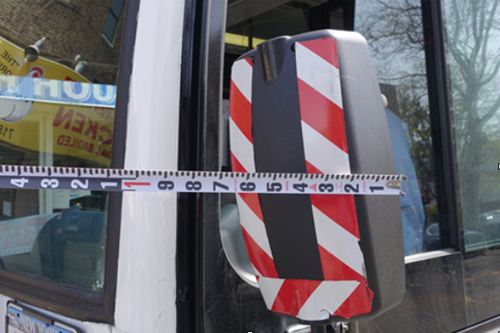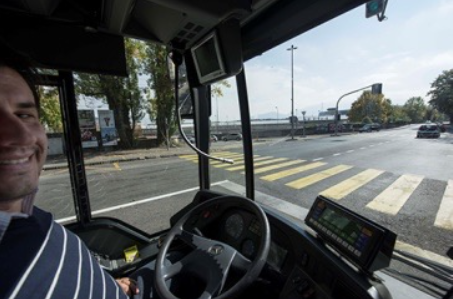Many buses have built-in blind spots that make driving them dangerous
A lot of people want to make Vision Zero a reality, ending preventable deaths on our streets. An often-overlooked barrier to making that happen is blind spots on our buses that leave people using the street at risk because drivers can’t see them. The good news is that fixing the problem is both easy and inexpensive.
Essentially, all transit buses in the United States are built as cheaply as possible, with mirrors and pillars that create blind spots that are over a foot wide. That’s too large for even the best-trained driver to reliably overcome, meaning people who share the street with buses are at risk. Since 2000, well over 500 people in the US have died because of this problem.
When policymakers invest in safe streets and pedestrian crossings, as well as dedicated lanes for transit and bikes, everyone benefits. Safety efforts like well engineered Vision Zero and safe street programs are no-brainers.
I work in the transit industry, where those of us who support effective Vision Zero campaigns talk about the path to safety being the classic checklist of the “three E’s:” it starts with engineering, which is followed by education, and only last comes enforcement.
In the case of these blind spots, policymakers have failed at the highest level: engineering. If we want to end fatalities, safe street engineering must not end at the curb.
On modern buses used in New York and DC, for example, the typical pillar and mirror, which are as wide as a legal pad at arm’s length, are directly in line with pedestrians in left turns. Over a dozen pedestrians can disappear behind a blind spot so large:
To compensate for the hazard, bus operators are taught to “bob and weave” or “rock and roll” in their seat. This means swaying nearly 20 inches, attempting to see around the widest pillar and mirror. Imagine doing that several times in every turn. Tragically, a moving operator and moving pedestrian can still remain unable to see each other. Additionally, poor cab design (like the huge steering wheel) confines all but tall operators, in some cases leaving them unable to lean more than a few inches.
Also, while safe bus mirrors are used in a few systems, most North American designs widen the blind spot and directly block the driver’s view of people walking in the street.
We can fix this problem, and for cheap
Larry Hanley, the president of the largest transit union in North America, has said these safety and engineering failures transform buses into “mobile manslaughter machines.”
One solution is to simply mount mirrors lower so that drivers can still see people walking in the street while also being able to monitor surrounding traffic. King County Metro in Seattle has already adopted the ATU-recommended design, a move that has saved numerous lives.
Similarly, structural changes are easy and inexpensive. In the case of the bus above, the engineer who designed it told the ATU that eliminating the blind spot between the windshield and side glass would cost less than $300: the fiberglass would just need trimming and the window seals would need to be out of critical sight lines.
The result? A smaller blind spot than in your car!
Change is not convenient, but in this case it is not difficult. Designs from 60 years ago were significantly safer, lacking these blind spots.
Changing buses means changing laws and culture
Unfortunately, North American manufacturers have chosen, at least for the moment, to stick with the status quo, a decision that saves pennies for themselves and transit procurement departments but costs lives.
Currently, neither the bus designers nor agency decision makers are being held legally responsible. Instead, that burden falls on drivers facing charges including manslaughter, while having no say in continuing purchases of unsafe vehicles, when excellent designs, as seen here, are ignored.
In DC, ATU Local 689 and ATU International have presented detailed findings about these local hazards and these low-cost solutions to WMATA and DDOT, both of which plan to procure more buses in the near future. Neither agency has committed to blind spot elimination in their procurement process.
As the truth of this unacceptable hazard and bloodshed it leads to become more broadly known, liability will eventually drive change. Public pressure from informed transit advocates can make repeating these mistakes uncomfortable for those selecting future fleets.
It is our hope that as riders, advocates, and workers awaken to the benefits of Vision Zero, they will demand that Mayor Bowser and the WMATA Board make these simple fixes. The welcome attention being paid to rail safety needs to also go toward Metrobus and DC Circulator service to help all of us move closer to zero fatalities on our streets and in our transit system.
The safety of bus riders, operators and people using the street should not rely on driver gymnastics or luck, and it need not continue to.




